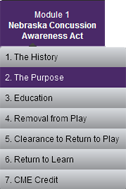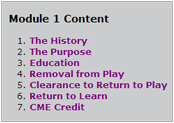Resources
Continuing Medical Education Credit
Children's Hospital & Medical Center CME
Top ⇧Experts in Concussion Recognition & Management
American Academy of Pediatrics (AAP) Team Model, a very important component that involves formation of a team to collaborate in caring for the student: Family Team; Medical Team; School Academic Team; School Physical Team.
American Congress of Rehabilitation Medicine (ACRM)
Brain Injury Association of Nebraska
CDC Injury Prevention & Control: Heads Up — to help you recognize, respond to, and minimize the risk of concussion or other serious brain injury.
CDC Concussion Definition and Pathophysiology
National Federation of State High School Associations (NFHS). Resources: Sports Medicine
Nebraska Concussion Coalition
Nebraska Department of Health & Human Services: Nebraska Injury Prevention Program
Nebraska Sports Concussion Network
REAP Concussion Management Program at Rocky Mountain Hospital for Children (Remove / Reduce, Educate, Accommodate, Pace)
Legislation
Nebraska Legislative Bill LB 260 (2011): The Concussion Awareness Act (history of adoption)
Nebraska Revised Statutes, Sections 71-9101 to 71-9106
Nebraska Concussion Awareness Act Amendment (2014)
Position Statements Regarding Concussion,
Statistics, & Reports
2015 Nebraska Sports Concussion Athletic Director Survey Results
2015 Nebraska Sports Concussion Head Coach Survey Results
2013 Nebraska Sports Concussion Athletic Director Survey Results
2013 Nebraska Sports Concussion Head Coach Survey Results
2013 Nebraska Sports Concussion Youth Survey Results
American Medical Society for Sports Medicine-2012. Harmon, KG, et al. American Medical Society for Sports Medicine position statement: concussion in sport. Br J Sports Med. 2013; 47:15-26.
American Academy of Neurology-2013. Giza C, Kutcher J, et al. Summary of evidence-based guideline update: Evaluation and management of concussion in sports. Neurology, 2013; 10.1212/WNL.0b013e31828d57dd.
Broglio SP, Cantu RC, Gioia GA et al. National Athletic Trainers Association: Management of Sport Concussion, 2014. J Athl Trng, 2014; 49:345-265.
Ciuffreda KJ, Kapoor N, Rutner D et al. Occurrence of oculomotor dysfunctions in acquired brain injury: a retrospective analysis. Optometry 2007; 78: 155-161.
Gessel, LM et al. Concussions Among United States High School and Collegiate Athletes. Journal of Athletic Training. 2007; 42(4): 495-503.
Hawryluk, G. W., & Manley, G. T. (2015). Classification of traumatic brain injury: past, present, and future. Handbook of Clinical Neurolology, 127, 15-21.
Institute of Medicine of the National Academies, Oct. 30, 2013. Sports-Related Concussions in Youth: Improving the Science, Changing the Culture.
Maerlender, A., Rieman, W., Lichtenstein, J., Condiracci, C. (2015). Programmed Physical Exertion in Recovery from Sports-Related Concussion: A Randomized Pilot Study. Developmental Neuropsychology, Published online, July 31, 2015; DOI:10.1080/87565641.2015.1067706.
Mueller, PhD, Frederick O. Annual Survey of Football Injury Research 1931-2010
Thomas, DG et al. Benefits of Strict Rest After Acute Concussion: A Randomized Controlled Trial. Pediatrics. 2015. 135(2): 1-11.
Zurich Statement 2013. McCrory P, Meeuwisse WH, Aubry M, et al. Consensus Statement on Concussion in Sport: the 4th International Conference on Concussion in Sport. Br J Sports Med. 2013; 47: 250-258.
Return to Learn
BIRSST Resources on the NDE Concussion and Brain Injury Supports page (including BIRSST Team Contacts)
BIRSST Return to Academics Progression
BIRSST Tips for Teachers (to help with accommodations for an injured student)
Bridging the Gap From Concussion to the Classroom. Nebraska Department of Education.
Halstead ME, McAvoy K, Devore CD, Carl R, Lee M, Logan K, Council on Sports Medicine and Fitness, and Council on School Health. Returning to Learning Following Concussion. Am Acad Pediatrics, 132 (5) 948-957, Nov 2013.
Section 504 Education Plan: FAQ about Section 405 and the Education of Children with Disabilities
Return to Play
Borg Rating of Perceived Exertion Scale. Use this scale as a way of measuring physical activity intensity level to help you evaluate a patient’s readiness to Return to Play.
Detailed Return to Play Progression, ImPACT, UPMC Sports Medicine Concussion Program Guidelines for Post-Concussion Rehabilitation
Example of Nebraska Sports Concussion Network Written Clearance / Permission Form
Sample NCHSAA Return to Play Clearance form
Tools
Assessment & Management Guide
Acute Concussion Evaluation (ACE) Care Plan
Acute Concussion Evaluation (ACE) Care Plan: Physician / Clinician Office Version
CDC Heads Up: Tools for Providers
DSM-V Diagnostic Criteria for Neurocognitive Disorders
ICD-10 Diagnostic Criteria for Post-Concussion Syndrome, Medscape.
Graded Symptom Scale Checklist
Pocket Concussion Recognition Tool
SCAT3™ for ages 13 and up
Child-SCAT3™ for children ages 5 to 12
Recommended Sleep Needed by Age, National Sleep Foundation
Video
Concussion Tools, Atlanta Children’s Hospital: 15 videos on Diagnosis, Treatment, Scenarios
Concussions: Heading for Change. NET Sports, 2014. Length = 26:39.
Website
Video
Conducting a Pediatric Concussion Evaluation, Children’s Hospital of Philadelphia
Evans Health Lab (to help patients understand concussion), by Dr. Mike Evans
I am not my label: Lily Sughroue, TEDx Lincoln. Length = 12:29.
What’s a Concussion, Anyway? Brain 101’s animation explains concussions to students. Length = 4:08.
You Look Great! — Inside a TBI. From the American Academy of Neurology 2011 Neuro Film Festival. Length = 6:20.
Site Map
HOME PAGE
Site Credits
| Content
Peg Ogea-Ginsburg NDHHS Injury Prevention Program Manager Peggy Reisher, MSW Brain Injury Association of Nebraska Executive Director Arthur Maerlender, PhD, ABPP Center for Brain, Biology, & Behavior Associate Director Rusty McKune, ATC The Nebraska Medical Center Sports Medicine Coordinator Kody Moffatt, MD, MS Children’s Hospital & Medical Center Director of Pediatric Sports Medicine David R. Schultz, MEd, ATC Nebraska Orthopaedic & Sports Medicine, PC Sports Medicine Outreach Program Manager Lori Terryberry-Spohr, PhD, ABPP Madonna Rehabilitation Hospital Brain Injury Program Manager |
Narrators Deirdre Barney Mark Epp Writer Peg Sheldrick Producer/Director Chet Kincaid Content Reviewer Jann Howard Content Assistant Jordan A. Knapp Center for Brain, Biology, & Behavior Research Assistant |
Web Master Laura Williams Graphic Artist Jenni Johnson Interactions Patrick Bate Web Tech Rakesh Adloori Alex Epperson Steve Exon Videographers John Beck David Barry Audio Engineers Werner Althaus Jim Lenertz Video Editors John Beck Chet Kincaid |
How to Use this Course
Navigation
 |
Select the course title on any page to return to the home page. |
 |
To access any page:
|
  |
Top ⇧
Sound
NOTE: The videos are self-contained, so need to be stopped individually before selecting another speaker icon on the page. |
Video
Videos within this course are either from the NET documentary, Concussions: Heading for Change, which reside on the netNebraska.org site or were created for this course and reside on the NDHHS YouTube channel.
|
Slideshows
|
Glossary & Page Text
  |
|
